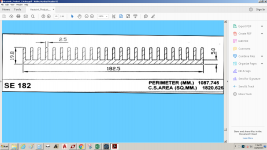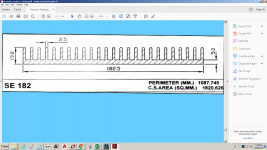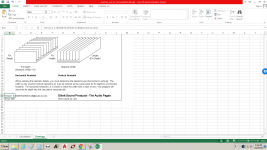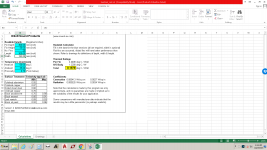Im thinking of using a heatsink which is used to dissipate 25W of heat in class A mode continuously at 35 degrees Centigrade room temperature. Now how much of Class AB power which I can use it safely? may be 50 degrees on the heatsink.
What temperature difference does the heatsink need to dissipate 25W?
Without that figure neither you nor us can guess at any useful number.
Without that figure neither you nor us can guess at any useful number.
here is one of the heatsink profile i would be using so can you please suggest how much length to be used for the 400W class AB subwoofer amplifier.
Voltage rails +/-73V load 4ohm.
How to calculate this so that the heatsink doesnt get much hot like 55 degrees C.
Voltage rails +/-73V load 4ohm.
How to calculate this so that the heatsink doesnt get much hot like 55 degrees C.
Attachments
Class A Sine is at-best 50% efficient, 50% to sink.
So a 100W sink supports a 100W output.
Class B Sine is at-best 78% efficient, 22% to sink.
So a 100W sink supports a 350W output.
So roughly 3X the output. (You see why Class A is not favored in commercial work.)
> 35 degrees Centigrade room temperature
> doesnt get much hot like 55 degrees C.
15 deg C *rise* is not much. I am conservative, but would design a class B amp for 50 deg rise. If you dissipate 25W at 15C on that sink, it should dissipate 75W at 50C. This suggests 260W output for a very good class B amp. The "50 deg C rise" limit is specifically for commercial (high power PA system) work, where the boom-de-boomp of the music cycles the temperature and strains the seals. Hi-Fi work can run much hotter at FULL power, because it never touches full power more than a few milli-seconds.
> +/-73V load 4ohm
If no rail sag, this computes to 625 Watts. In home use, it still may live forever. I would not take 600 Watts on a 7" by ?? sink to do the Hot Tuna concert.
So a 100W sink supports a 100W output.
Class B Sine is at-best 78% efficient, 22% to sink.
So a 100W sink supports a 350W output.
So roughly 3X the output. (You see why Class A is not favored in commercial work.)
> 35 degrees Centigrade room temperature
> doesnt get much hot like 55 degrees C.
15 deg C *rise* is not much. I am conservative, but would design a class B amp for 50 deg rise. If you dissipate 25W at 15C on that sink, it should dissipate 75W at 50C. This suggests 260W output for a very good class B amp. The "50 deg C rise" limit is specifically for commercial (high power PA system) work, where the boom-de-boomp of the music cycles the temperature and strains the seals. Hi-Fi work can run much hotter at FULL power, because it never touches full power more than a few milli-seconds.
> +/-73V load 4ohm
If no rail sag, this computes to 625 Watts. In home use, it still may live forever. I would not take 600 Watts on a 7" by ?? sink to do the Hot Tuna concert.
Class A Sine is at-best 50% efficient, 50% to sink.
So a 100W sink supports a 100W output.
Class B Sine is at-best 78% efficient, 22% to sink.
So a 100W sink supports a 350W output.
So roughly 3X the output. (You see why Class A is not favored in commercial work.)
> 35 degrees Centigrade room temperature
> doesnt get much hot like 55 degrees C.
15 deg C *rise* is not much. I am conservative, but would design a class B amp for 50 deg rise. If you dissipate 25W at 15C on that sink, it should dissipate 75W at 50C. This suggests 260W output for a very good class B amp. The "50 deg C rise" limit is specifically for commercial (high power PA system) work, where the boom-de-boomp of the music cycles the temperature and strains the seals. Hi-Fi work can run much hotter at FULL power, because it never touches full power more than a few milli-seconds.
> +/-73V load 4ohm
If no rail sag, this computes to 625 Watts. In home use, it still may live forever. I would not take 600 Watts on a 7" by ?? sink to do the Hot Tuna concert.
one of my heatsink which i use for class A amp is currently dissipating 25W at 35 degrees room temp and the heatsink temperature is about 50 degree centigrade.
It depends on how high the amp is biased and how hard it will be driven, worst case. Class AB is at best 78%, but typically something more like 65% to 70%. If you are making a pro amp which can see a lot of compressed program input, the conservative thing to do is to design for full sinewave drive, assume 65% or 75%. Of course, HT receivers with 6x150W amps in them aren't designed like that nor are most hifi amps, since average music output is a lot lower than peak. So you could probably design for something like maybe 85% effective in-use efficiency (not because efficiency gets lower at lower power, it mostly doesn't -- but because the average power with music that hits maximum power peaks is usually pretty low assuming use by a sane user).
If you want the same 15 degree temp rise when you're operating your amp, you'd be dissipating the same 25W average. Assuming the same orientation, mounting and airflow, of course. So if you were using the less conservatlve "85% effective" value, solve
Mounting orientation and air flow will have a big effect on the temp rise of the heatsink. And the junction temp of the parts being heatsunk (which is the most important parameter to watch) will vary depending on how well they are mounted, and how well distributed on the heatsink (avoiding hotspots). Also on what kind if insulators are used. Your 50C at 35C is pretty conservative but I'd still avoid the stretchy type insulators and use mica or alumina instead, or the Keratherm types if you can afford them.
If you want the same 15 degree temp rise when you're operating your amp, you'd be dissipating the same 25W average. Assuming the same orientation, mounting and airflow, of course. So if you were using the less conservatlve "85% effective" value, solve
25=(1-0.85)*MaxDesignedOutputPower
MaxDesignedOutputPower= 25/(1-0.85)=167W
MaxDesignedOutputPower= 25/(1-0.85)=167W
Mounting orientation and air flow will have a big effect on the temp rise of the heatsink. And the junction temp of the parts being heatsunk (which is the most important parameter to watch) will vary depending on how well they are mounted, and how well distributed on the heatsink (avoiding hotspots). Also on what kind if insulators are used. Your 50C at 35C is pretty conservative but I'd still avoid the stretchy type insulators and use mica or alumina instead, or the Keratherm types if you can afford them.
Last edited:
If you use a 100W heatsink to support a 100W Class A output then you had better ensure that the music plays at full volume all the time. As soon as the music stops you have 200W of heat to get rid of! Different from Class B, which has low efficiency at low volume but fortunately lower power at low volume too.PRR said:Class A Sine is at-best 50% efficient, 50% to sink.
So a 100W sink supports a 100W output.
400W/100% =4........4x30 (% heat ) =120W heatsink heat ........ 25 degrees/120W = 0.2 degrees C/W .......so what ever length gives you 0.2 .
Last edited:
For a class b stage, the maximum average dissipation is vcc^2/(10*R), in each transistor. real world is less, even when being 'blasted'. It can be simulated. Not necessarily with a spice simulator, but with a behavioral model. Power dissipation is just the VI product in the transistor (I*(vcc-vout)). Numerical integration is dirt simple. I've done it with excel spreadsheets and basic programs. Even for more complex classes like G and H. The trick is the input signal. What you simulate depends on this. What you want is a digital representation of band limited pink noise. A sound card can generate it. I've just used bounded random number sequences, driven up (and clipped) to give a specific peak to average ratio for the signal itself. Then feed that in to the simulation, integrate, and get a result.
ClassAB heatsinks get two sources of heat input.
The quiescent heat from the output bias and a variable proportion of the output signal power.
I have used 100W ClassAB amplifiers that appear cold to the touch when playing quietly.
And yet other 100W ClassAB amplifiers that are so hot playing no signal that they cannot be comfortably touched for more than a couple of seconds.
The heatsink temperature has almost no correlation to the tiny amounts of power, typically less than 1W, that are sent to the speaker.
And I just don't believe that the heatsink shown in post3 rises by only 15C degrees when 25W is being dissipated.
The quiescent heat from the output bias and a variable proportion of the output signal power.
I have used 100W ClassAB amplifiers that appear cold to the touch when playing quietly.
And yet other 100W ClassAB amplifiers that are so hot playing no signal that they cannot be comfortably touched for more than a couple of seconds.
The heatsink temperature has almost no correlation to the tiny amounts of power, typically less than 1W, that are sent to the speaker.
And I just don't believe that the heatsink shown in post3 rises by only 15C degrees when 25W is being dissipated.
Epicyclic seems to think similarly.is currently dissipating 25W at 35 degrees room temp and the heatsink temperature is about 50 degree centigrade.
Last edited:
I usually go by the degree's C per watt rating of the heat sink.
It tells you how many degree's the heat sink temp will rise per watt dissipated.
You need to look up how many watts your map will dissipate to get the correct numbers.
Class a is worst then class ab then class d.
It tells you how many degree's the heat sink temp will rise per watt dissipated.
You need to look up how many watts your map will dissipate to get the correct numbers.
Class a is worst then class ab then class d.
> If you use a 100W heatsink.... As soon as the music stops you have 200W
You are quite correct, even the bit about "don't stop!"
I think my fat fingers got ahead of my small mind. Trying Again:
Class A Sine is at-best 50% efficient, 50% to sink.
So a 100W sink supports at-best a 50W output.
Class B Sine is at-best 78% efficient, 22% to sink.
So a 100W sink supports a 350W output.
So roughly 6X the output.
You are quite correct, even the bit about "don't stop!"
I think my fat fingers got ahead of my small mind. Trying Again:
Class A Sine is at-best 50% efficient, 50% to sink.
So a 100W sink supports at-best a 50W output.
Class B Sine is at-best 78% efficient, 22% to sink.
So a 100W sink supports a 350W output.
So roughly 6X the output.
Last edited:
Umm... calculation in post#15 is done for the fin height 50mm, but the picture in post #14 is showing the fin height 19.8mm - much shorter fins. So... what's the point? 🙄
Also... just as a thought for consideration. In class AB amplifiers - the harder you drive, the hotter it gets. So, at normal home listening levels, it runs rather cool. In class A - constant maximum dissipation, regardless of how hard you drive it. It will dissipate the full power even with no signal. The heatsink is never too big in this case. Take some extra size, if you can.
Also... just as a thought for consideration. In class AB amplifiers - the harder you drive, the hotter it gets. So, at normal home listening levels, it runs rather cool. In class A - constant maximum dissipation, regardless of how hard you drive it. It will dissipate the full power even with no signal. The heatsink is never too big in this case. Take some extra size, if you can.
I think this one will help
the one with variable speed with temperature.
Detecting failure in dc cooling fans - Electronic Products
the one with variable speed with temperature.
Detecting failure in dc cooling fans - Electronic Products
I think this one will help
the one with variable speed with temperature.
Detecting failure in dc cooling fans - Electronic Products
It can be done easier - using appropriate algorithm with our 21-st century microcontroller-based control board (see the link in my signature).
As soon as the heatsink temperature reaches, say, 80 degrees, the fan (or fans) switch on. If by some reason (fan failure or something else) the heatsink temperature raises up to 90 degrees, we shut down the amp.
In more sophisticated configuration, we can control the fan speed.
- Status
- Not open for further replies.
- Home
- Amplifiers
- Solid State
- 25W continuous heat dissipation heatsink can be used for how much class AB power



